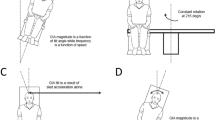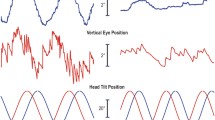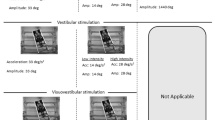Abstract
We measured human ocular torsion (OT) monocularly (using video) and binocularly (using search coils) while sinusoidally accelerating (0.7 g) five human subjects along an earth-horizontal axis at five frequencies (0.35, 0.4, 0.5, 0.75, and 1.0 Hz). The compensatory nature of OT was investigated by changing the relative orientation of the dynamic (linear acceleration) and static (gravitational) cues. Four subject orientations were investigated: (1) Y-upright — acceleration along the interaural (y) axis while upright; (2) Y-supine — acceleration along the y-axis while supine; (3) Z-RED — acceleration along the dorsoventral (z) axis with right ear down; (4) Z-supine — acceleration along the z-axis while supine. Linear acceleration in the Y-upright, Y-supine and Z-RED orientations elicited conjugate OT. The smaller response in the Z-supine orientation appeared disconjugate. The amplitude of the response decreased and the phase lag increased with increasing frequency for each orientation. This frequency dependence does not match the frequency response of the regular or irregular afferent otolith neurons; therefore the response dynamics cannot be explained by simple peripheral mechanisms. The Y-upright responses were larger than the Y-supine responses (P<0.05). This difference indicates that OT must be more complicated than a simple low-pass filtered response to interaural shear force, since the dynamic shear force along the interaural axis was identical in these two orientations. The Y-supine responses were, in turn, larger than the Z-RED responses (P<0.01). Interestingly, the vector sum of the Y-supine responses plus Z-RED responses was not significantly different (P=0.99) from the Y-upright responses. This suggests that, in this frequency range, the conjugate OT response during Y-upright stimulation might be composed of two components: (1) a response to shear force along the y-axis (as in Y-supine stimulation), and (2) a response to roll tilt of gravitoinertial force (as in Z-RED stimulation).
Similar content being viewed by others
References
Arrott AP (1985) Ocular torsion and gravitoinertial force. PhD, MIT
Arrott AP, Young LR (1983) Attenuation of the otolith-ocular torsion reflex by changing orientation with respect to gravity. 13th Annual Meeting of Soc Neurosci, Boston, Mass., Nov. 6–11
Bucher UJ, Mast F, Bischof N (1992) An analysis of ocular couterrolling in response to body positions in three dimensional space. J Vestib Res 2:213–220
Clarke AH, Teiwes W, Scherer H (1991) Video-oculography — an alternative method for measurement of three dimensional eye movements. In: Schmidt R, Zambarbieri D (eds) Oculomotor control and cognitive processes. Elsevier, Amsterdam, pp 432–443
Collewijn H, Van der Steen J, Ferman L, Jansen T (1985) Human ocular counterroll: assessment of static and dynamic properties from electromagnetic scleral coil recordings. Exp Brain Res 59:185–196
Diamond SG, Markham CH (1983) Ocular counterrrolling as an indicator for vestibular otolith function. Neurology 33:1460–1469
Fernandez C, Goldberg J (1976a) Physiology of peripheral neurons innervating the otolith organs of the squirrel monkey. II. Directional selectivity and force-response relations. J Neurophysiol 39:985–995
Fernandez C, Goldberg J (1976b) Physiology of peripheral neurons innervating the otolith organs of the squirrel monkey. III. Response dynamics. J Neurophysiol 39:996–1008
Howard I (1964) Visually-induced eye torsion and tilt adaptation. Vision Res 4:433–437
Howard IP, Evans JA (1963) The measurement of eye torsion. Vision Res 3:447–455
Johnson RA, Wichern DW (1982) Applied multivariate statistical analysis. Prentice-Hall, Englewood Cliffs, NJ
Kellogg RS (1965) Dynamic counterrolling of the eye in normal subjects and in persons with bilateral labyrinthine defects. In: The role of the vestibular organs in the exploration of space. US Gov Printing Office, Washington, DC, pp 195–202
Lathan CE, Wall C, Harris LR (1995) Human eye movement response to z-axis linear acceleration: the effect of varying the phase relationships between visual and vestibular inputs. Exp Brain Res 103:256–266
Lichtenberg BK, Young LR, Arrott AP (1982) Human ocular counterrolling induced by varying linear accelerations. Exp Brain Res 48:127–136
Markham C (1989) Anatomy and physiology of otolith-controlled ocular counterrolling. Acta Otolaryngol (Stockh) [Suppl] 468:263–266
Markham C, Diamond SG (1985) Dynamic ocular counter-rolling: a comparison of responses to naso-occipital and barbecue rotations in normal subjects and in patients with unilateral vestibular nerve sections. In: Igarashi M, Black FO (eds) Vestibular and visual control of posture and locomotor equilibrium. Karger, Basel, pp 246–250
Markham CH, Estes MS, Blanks RH (1973) Vestibular influences on ocular accommodation in cats. Equilib Res 3:102–115
Merfeld DM (1995) Modeling the vestibulo-ocular reflex of the squirrel monkey during eccentric rotation and roll tilt. Exp Brain Res 196:123–134
Merfeld DM, Young LR (1995) The vestibulo-ocular reflex of the squirrel monkey during eccentric rotation and roll tilt. Exp Brain Res 106:111–122
Merfeld DM, Christie JRI, Young LR (1994) Perceptual and eye movement responses elicited by linear acceleration following spaceflight. Aviat Space Environ Med 65(11):1015–1024
Merfeld DM, Teiwes W, Clarke AH, Scherer H, Young LR (1995) Ocular torsion induced by dynamic linear acceleration is context dependent (abstract). Conference on Neurology of Human Spatial Orientation, Ibiza, Spain, May 15–19
Miller EF (1962) Counterrolling of the human eyes produced by head tilt with respect to gravity. Acta Otolaryngol (Stockh) 54:479–501
Miller EF (1970) Evaluation of otolith organ function by means of ocular counterrolling measurements. In: Stahle J (ed) Vestibular function on earth and in space. Pergamon, Oxford, pp 97–107
Miller EF, Graybiel A (1971) Effect of gravitoinertial force on ocular counterrolling. J Appl Physiol 31(5):697–700
Miller EF, Graybiel A, Kellogg RS (1966) Otolith organ activity within Earth standard, one-half standard and zero gravity environments. Aerospace Med 40 (8) 40: 399–403
Paige G, Tomko D (1991) Eye movement responses to linear head motion in the squirrel monkey. I. Basic characteristics. J Neurophysiol 65(5):1170–1182
Suzuki J Tokumasu K, Goto K (1969) Eye movements from single utricular nerve stimulation in the cat. Acta Otolaryngol (Stockh) 68:350–362
Teiwes W (1991) Video-oculography — registration of eye movement in three degrees of freedom for the investigation and medical diagnosis of the vestibular system. PhD, Free University of Berlin
Teiwes W, Clarke AH, Merfeld DM, Oman CM, Scherer H, Young LR (1993) Otolithic contribution to torsional eye movements during dynamic linear acceleration. Fuchs A, Brandt T, Büttner U, Zee D (eds) Contemporary ocular motor and vestibular research: a tribute to David A Robinson. Thieme, New York, pp 363–365
Walton WG (1948) Compensatory cyclo-torsion accompanying head tilt. Am J Optom 25(11):525–534
Woellner RC, Graybiel A (1959) Counterrolling of the eyes and its dependence on the magnitude of gravitational or inertial force acting laterally on the body. J Appl Physiol 14(4):632–634
Young LR, Lichtenberg BK, Arrott AP, Crites TA, Oman CM, Edelamn ER (1981) Ocular torsion on Earth and in weightlessness. Ann NY Acad Sci 374:80–92
Young LR, Teiwes W, Clarke A, Merfeld DM, Oman C, Scherer H (1993) Otolithic contribution to torsional eye movements during dynamic linear acceleration (abstract). Aviat Space Environ Med 64(5):457
Author information
Authors and Affiliations
Rights and permissions
About this article
Cite this article
Merfeld, D.M., Teiwes, W., Clarke, A.H. et al. The dynamic contributions of the otolith organs to human ocular torsion. Exp Brain Res 110, 315–321 (1996). https://doi.org/10.1007/BF00228562
Received:
Accepted:
Issue Date:
DOI: https://doi.org/10.1007/BF00228562




